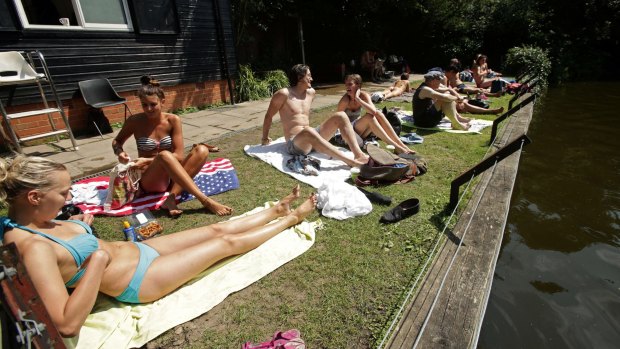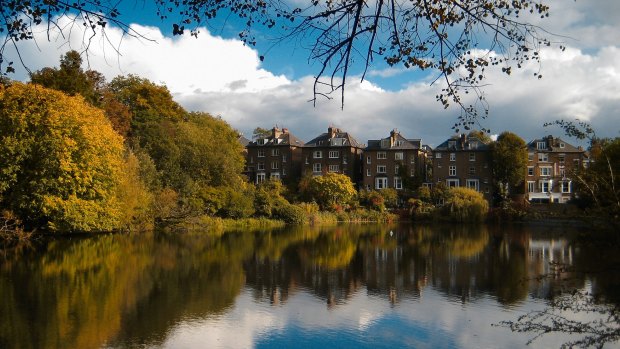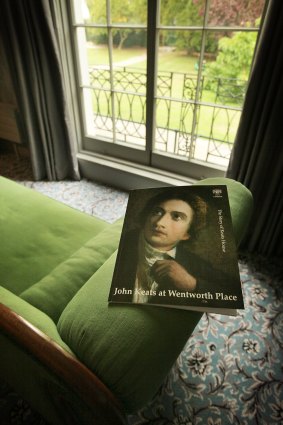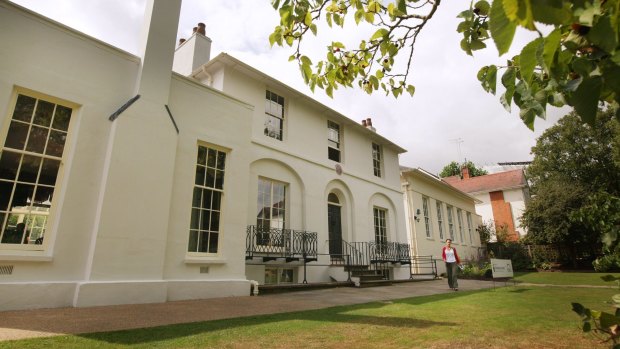This was published 7 years ago
Keats House and Hampstead Heath bathing ponds: Where London gets back to nature
By Steve Meacham

Hampstead Heath's mixed bathing pond: The one where bathers are required.Credit: Alamy
Hampstead's bathing ponds are both famous and notorious. There are three: male, female and mixed – and cossies are only required in the mixed pond.
So my sons – 14 and 12 – are already deeply concerned as we stroll across Hampstead Heath in search of them.
They're canny enough to realise my backpack does not have enough room for three sets of cossies and towels, and fear I may insist they go skinny-dipping in that non-summer gloom Londoners refer to as "broad daylight".

A stunning view of a pond in Hampstead Heath on a cloudy day.
Thirty years ago, I lived on the very edge of this heath – London's most natural (and arguably its most beautiful) open space, just six kilometres north of Trafalgar Square.
So our last day of a family visit to England is spent showing them the things I used to love about living in Hampstead.
Flying kites on Parliament Hill with a seemingly endless stream of nieces and nephews. Morning jogs, nodding hello to local fellow runners such as Michael Palin and Sting. Summer picnics on West Meadow, followed by a classical concert at heritage-listed Kenwood House.

A brochure showing a portrait of John Keats sits on a chaise lounge.Credit: Getty Images
And, of course, those romantic-sounding but hygienically challenged dips at the mixed pond (skinny-dipping was never really my thing in the cold).
This morning a few hardy locals are braving the duck-poo and autumnal chill when we emerge at the mixed pond from the charming woodlands of the Vale of Health and East Heath. But my sons take one look at the coffee-coloured water and swear they'll never dip a toe into it, let alone risk a few laps.
Hampstead (and its neighbour Highgate on the opposite side of the heath) are two of London's most desirable addresses – long the haunt of writers, artists, actors, musicians and politicians. Blue plaques abound in virtually every street, signalling someone famous – George Orwell, J.B. Priestley, John Constable or Sir Edward Elgar, for example – lived in that particular house.

Hampstead Heath has been transformed thanks to a Heritage Lottery Fund grant.Credit: Getty Images
If Paris has Montmartre, London has Hampstead.
Yet Hampstead's most evocative resident will forever be the doomed poet John Keats – despite the fact he lived in Wentworth Place, his last home in England, for less than two years (between 1818 and 1820).
Keats House Museum is where he wrote Ode to a Nightingale and where he met neighbour Fanny Brawne, his fiancee before his death from tuberculosis in Rome in 1821, aged 25.
A visit to Keats House also reminds you that, in 1820, Hampstead really was a country village on London's highest vantage point with spectacular views over the city. (I could see St Paul's Cathedral from my flat every morning in the 1980s: sadly the view is now obscured by skyscrapers.)
What changed Hampstead's fortunes was the discovery of "medicinal" waters around 1810. Long before railways, buses or cars inspired London's suburbia, Hampstead had been reinvented as a fashionable spa town (reflected in street names such as Well Walk). That's why Keats came, hoping the clean air and sweet waters would stave off the family curse of "consumption".
It's been three decades since I last saw Hampstead. And, when the Northern Line dropped us at Hampstead tube station, I'd been relieved to find its character unchanged.
Even La Creperie de Hampstead, the food van that has been serving delicious sweet and savory French-style crepes in Hampstead High Street, since 1980, is still there – thanks to a petition signed by 12,000 customers when a feud with the landlord of the neighbouring King William IV pub threatened to close it.
Pubs have always been part of the fabric of Hampstead life. Personally, my favourite was always The Flask, just round the corner from the tube station in Flask Walk. So, for old time's sake, we pop in for a look ("Really boys? OK, if you insist!").
The dark-wooded public bar and front saloon, separated by a heritage-listed mahogany and glass screen, is barely altered since the "new" pub was built in 1874 (on the site of the 1700s original).
Stepping inside is like being transported back to the 1930s. You expect John Betjeman or Kingsley Amis (former locals) to be propped up in the corner. Especially when you see the bar snacks. Sausage roll "sold by the inch" and old-fashioned "scotch eggs with mustard" (although the modern rear conservatory now houses a restaurant).
Within 100 metres of The Flask you'll spot quirky shops selling the kind of things Hampstead is famous for. Second-hand books, flowers, antiques, and art.
These days, the fashion boutiques are more high-end, and the Parisian-style cafes and patisseries tend not to be family-owned but upmarket international brands. Still, the mix is much as I remember it.
But my sons and I have come to Hampstead for its heath. After the ponds (and check their opening times because they were being renovated in 2016), we start heading across the heath to our ultimate destination – the Spaniards Inn.
According to legend, highwayman Dick Turpin was a regular. As were Keats, Byron and painter Joshua Reynolds. The Spaniards also features in both The Pickwick Papers by Dickens and Bram Stoker's Dracula.
Did we get there? No. My sons, having seen La Creperie de Hampstead, were desperate for French cuisine after those scotch eggs.
Culture? You can't give it away to the modern generation.
TRIP NOTES
MORE
TRAIN
Hampstead Heath is easily accessible from Central London via Northern Line Tube (Hampstead), rail (Hampstead Heath) or bus (including 24, 46, 210, 214, 268).
TOUR
Keats House Museum: www.londonshh.org
Steve Meacham travelled at his own expense.
See also: The 20 must-do highlights of London
Sign up for the Traveller Deals newsletter
Get exclusive travel deals delivered straight to your inbox. Sign up now.